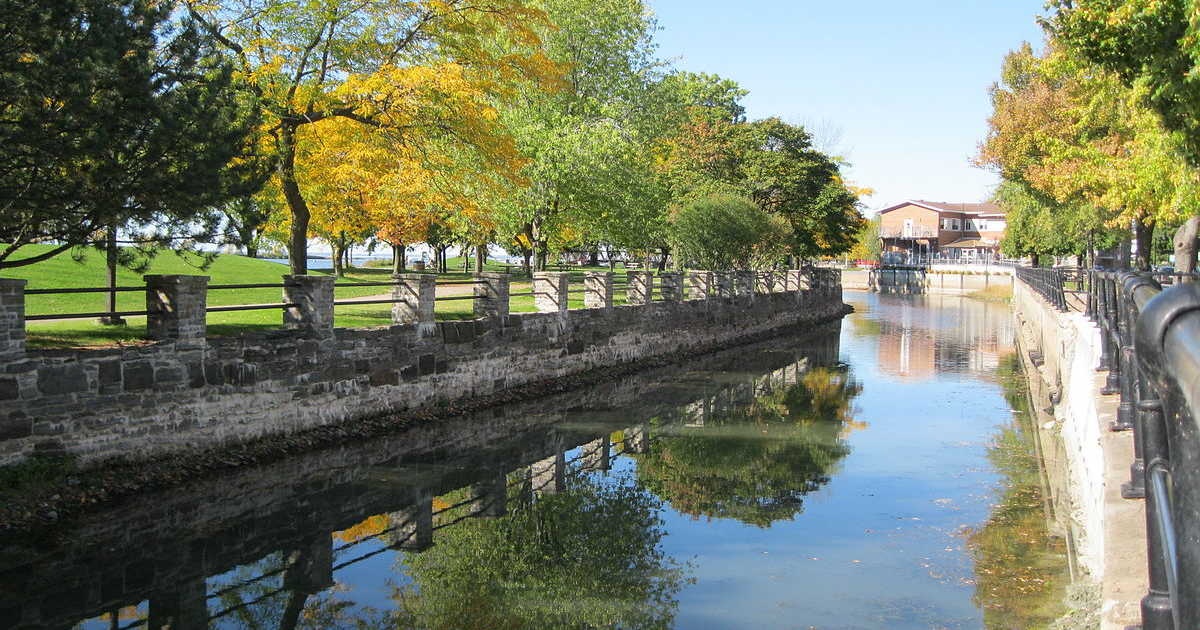As you plan your Montreal visit, consider the Lachine Canal, a National Historic Site and a cornerstone in Montreal’s tourism and industrial history since 1825. This 14.5 km scenic waterway, connecting the Old Port to Lake Saint-Louis, is not just a destination but a journey through Montreal’s rich cultural landscape, offering picturesque views that are quintessentially Montreal-Quebec.
The Lachine Canal experience is diverse, catering to all interests — from history enthusiasts to nature lovers and recreation seekers. With accessible exploration options such as walking, biking, or boat tours, it’s a prime example of how to explore Montreal in an engaging way, making it a top destination among Montreal tourist attractions.
The History and Cultural Impact of the Lachine Canal
The Lachine Canal, inaugurated in 1825, was a pivotal development in transforming Montreal into a bustling port city, attracting industries to its banks. This transformation was largely due to its significant expansions between 1843 and 1849, nearly doubling its width and depth to accommodate the growing industrial demand. Here’s a brief overview:
- 1825: The canal opens, marking the beginning of Montreal’s evolution into a major port.
- 1843-1849: Major expansions double the canal’s size, boosting its capacity for industrial development.
- 1996: Recognition of its historical importance with its designation as a National Historic Site of Canada.
The idea of bypassing the Lachine Rapids, a major obstacle for maritime navigation, dates back to the foundation of Ville-Marie (Montreal) in 1671, with initial construction attempts disrupted by conflicts. Despite these early setbacks, the canal’s completion and subsequent enlargements in 1843-1848 and 1873-1884 played a crucial role in facilitating shipping and tonnage, leading to its peak usage just before the 1929 crisis.
- 1671: Initial plans to circumvent the Lachine Rapids.
- 1689: Construction begins but is halted due to conflict.
- 1825, 1843-1848, 1873-1884: Construction and enlargements to accommodate shipping needs.
The canal’s industrial peak and subsequent decline, leading to its closure to shipping in 1970, reflect the changing dynamics of maritime transportation and industrial practices. However, since 1997, a significant revitalization effort has been underway, transforming the canal into a recreational hotspot, reopening it to pleasure boating in 2002, and preserving its rich industrial heritage.
- 1929: Nearly 15,000 ships annually signal the canal’s peak industrial activity.
- 1970: Closure to shipping due to the canal’s inability to accommodate larger vessels.
- 1997-present: Revitalization efforts focus on recreational use and historical preservation.
Recreational Activities Along the Canal
Exploring the Lachine Canal offers a plethora of recreational activities suited for every visitor, whether you’re looking to immerse yourself in nature, engage in physical activity, or simply enjoy a leisurely day out. Here’s a breakdown of what you can expect:
- Outdoor Activities:
- Biking and Walking: With rental services available near the wharf, you can easily pick up a bike or simply stroll along the canal’s path. The Lachine Canal Multipurpose Path stretches from the Old Port to Lachine, perfect for cyclists, strollers, and picnickers.
- Boating and Water Sports: Pleasure boating, kayaking, and canoeing are popular, with rentals available for those looking to paddle the waters. Stand-up paddleboarding and rowing offer alternative ways to enjoy the canal.
- Winter Sports: During the colder months, the canal transforms, offering cross-country skiing and snowshoeing along six kilometers of its path.
- Cultural and Social Experiences:
- Festivals and Events: The canal hosts several festivals throughout the year, including the Lachine Canal Festival and the Montreal Folk Festival on the Canal, providing entertainment and cultural enrichment.
- Cafés and Restaurants: The Canal Lounge and numerous eateries along the canal offer a variety of food and drink options, allowing for relaxing breaks amidst activities.
- Art and Wildlife: Public art installations and abundant wildlife along the canal enrich the scenic beauty, making every visit unique.
- Practical Information:
- Accessibility: The canal is easily accessible by public transit, with several bus and metro stops nearby. Parking is available, with prices ranging from CAD 5 to CAD 15 for the day.
- Safety and Regulations: The canal is patrolled to ensure visitor safety. Rules include no littering, no swimming, and no motorized vehicles on the pathways. For more details, Parks Canada can be contacted directly.
This comprehensive array of activities ensures that every visit to the Lachine Canal is memorable, offering something for everyone, from the avid adventurer to those seeking a tranquil escape in Montreal’s urban landscape.
The Lachine Canal’s Role in Montreal’s Urban Landscape
The Lachine Canal has been a vital artery in Montreal’s urban fabric, weaving through the city’s history and landscape. Its influence on Montreal’s development is multifaceted:
- Industrial Catalyst: Initially serving as a critical link connecting the Atlantic to the continent’s heart, the canal spurred Montreal’s industrial boom. It attracted a myriad of businesses leveraging its strategic location, hydraulic power, and proximity to markets. This industrial surge led to the creation of bustling suburbs and a significant population increase, laying the groundwork for Montreal’s urban sprawl.
- Recreational Haven: Today, the canal is encircled by lush parks and green spaces, providing a serene escape from urban life. The Atwater Market, nestled between Lock Nos. 3 and 4, is a popular spot offering fresh local produce and goods. The canal’s transformation into a recreational hub has enriched Montreal’s lifestyle, offering activities ranging from picnics to various water sports along its 14.5 kilometers stretch from the Old Port to Lake Saint-Louis.
- Accessibility and Education: The Lachine Canal is accessible year-round, with public transportation options nearby and parking available for those driving. It’s not just a place for leisure but also learning, with the National Historic Site offering educational programs and activities. This accessibility ensures that the canal remains a vibrant part of Montreal’s urban landscape, inviting visitors to explore its history, enjoy its present, and anticipate its future developments.
Future Developments and Conservation Efforts
As you continue to explore and enjoy the Lachine Canal, it’s exciting to note the ongoing developments and conservation efforts that promise to enhance your experience. Here are some key future initiatives:
- Interactive and Educational Enhancements:
- The Lachine Canal Visitor Centre offers exhibitions and interactive displays for a deep dive into the canal’s history.
- Free WiFi at the kiosk near the wharf enables the use of the Explora mobile app, an interactive guide to the canal.
- Infrastructure and Conservation Projects:
- Implementation of the Federal Infrastructure Investment Program focuses on improving the integrity of cultural resources and the canal’s buildings and engineering structures.
- Restoration efforts include the canal walls, the Canal’s Workshops, and the Gauron and Lafleur bridges.
- The Lachine Canal 4.0 project aims to improve alternative mobility, leisure areas, and local shops, covering almost 2 million square meters across LaSalle, Lachine, and Southwest boroughs.
- Community and Visitor Experience:
- Parks Canada is investing over $9 million to rebuild the lighting system along the canal path, enhancing safety and visibility.
- Major projects nearby and the development of neighborhoods adjacent to the canal are underway, with regular consultations to ensure community integration.
- Outdoor education programs and the inauguration of the North Link aim to enrich the visitor experience and educational offerings.
These initiatives, part of a broader effort to preserve the canal’s heritage while adapting to modern needs, ensure that the Lachine Canal remains a cherished destination for both locals and tourists.
Conclusion
Throughout this exploration of the Lachine Canal, we’ve delved into its historical significance, recreational offerings, and the role it plays in Montreal’s vibrant urban tapestry. Its transformation from an industrial lifeline to a recreational haven underscores Montreal’s adaptability and commitment to preserving and celebrating its cultural heritage. The canal not only serves as a picturesque backdrop for a myriad of activities but also stands as a testament to the city’s ongoing efforts to blend history with modern leisure and educational opportunities.
Looking ahead, the future developments and conservation efforts promise to further enrich the canal’s legacy and its offering to both residents and visitors. As the Lachine Canal continues to evolve, so does its contribution to Montreal’s identity and appeal as a destination that honors its past while embracing the future. This dynamic interplay of history, culture, and recreation ensures that the Lachine Canal experience remains a unique and cherished part of the city’s narrative, inviting all who visit to create their own memories along its waters.
FAQs
Q: What is the length of the Lachine Canal bicycle path? A: The Lachine Canal bicycle path extends for 14.5 kilometers and is a part of the bicycle network in the Sud-Ouest borough on the island of Montréal. It stretches from the Bonaventure Expressway west of the Old Port to Chemin du Musée in Lachine.
Q: What makes the Lachine Canal historically significant? A: Historically, the Lachine Canal played a crucial role in providing hydraulic energy, which was pivotal for the industrial and commercial growth of both the City of Montreal and Canada as a whole. It served as an industrial corridor and was among the primary locations where Canada’s manufacturing industry originated.
Q: For what reasons is the Lachine Canal occasionally drained? A: The Lachine Canal is drained periodically by Parks Canada to conduct maintenance and restoration work. Draining the canal allows technicians to inspect and maintain essential components of the canal’s infrastructure, particularly the locks, to ensure their safe operation.
Q: How many locks are there along the Lachine Canal? A: The Lachine Canal features a total of 5 locks along its 14-kilometer waterway. Traveling through these locks provides a unique and memorable navigation experience, leading visitors to some of the city’s most popular attractions.


Leave a Reply
You must be logged in to post a comment.